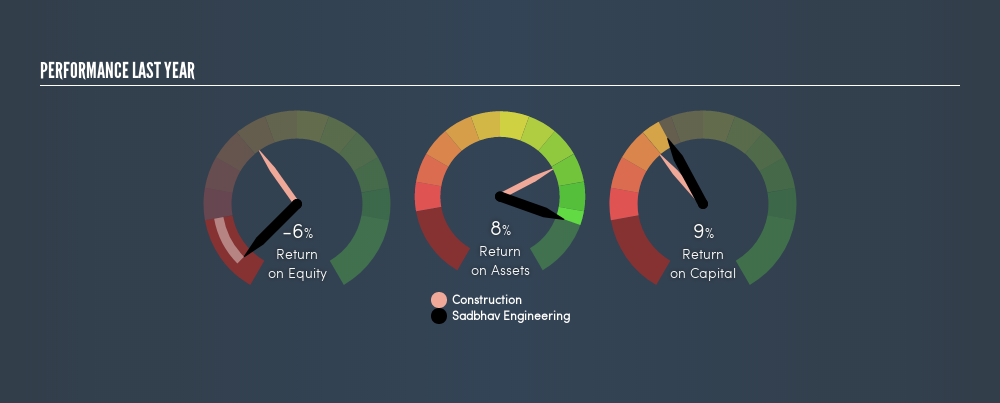- India
- /
- Construction
- /
- NSEI:SADBHAV
How Do Sadbhav Engineering Limited’s (NSE:SADBHAV) Returns Compare To Its Industry?
Want to participate in a short research study? Help shape the future of investing tools and you could win a $250 gift card!
Today we'll evaluate Sadbhav Engineering Limited (NSE:SADBHAV) to determine whether it could have potential as an investment idea. To be precise, we'll consider its Return On Capital Employed (ROCE), as that will inform our view of the quality of the business.
First of all, we'll work out how to calculate ROCE. Then we'll compare its ROCE to similar companies. Finally, we'll look at how its current liabilities affect its ROCE.
Understanding Return On Capital Employed (ROCE)
ROCE is a metric for evaluating how much pre-tax income (in percentage terms) a company earns on the capital invested in its business. All else being equal, a better business will have a higher ROCE. Ultimately, it is a useful but imperfect metric. Author Edwin Whiting says to be careful when comparing the ROCE of different businesses, since 'No two businesses are exactly alike.'
How Do You Calculate Return On Capital Employed?
The formula for calculating the return on capital employed is:
Return on Capital Employed = Earnings Before Interest and Tax (EBIT) ÷ (Total Assets - Current Liabilities)
Or for Sadbhav Engineering:
0.086 = ₹11b ÷ (₹161b - ₹34b) (Based on the trailing twelve months to March 2019.)
So, Sadbhav Engineering has an ROCE of 8.6%.
See our latest analysis for Sadbhav Engineering
Is Sadbhav Engineering's ROCE Good?
When making comparisons between similar businesses, investors may find ROCE useful. Using our data, Sadbhav Engineering's ROCE appears to be significantly below the 13% average in the Construction industry. This could be seen as a negative, as it suggests some competitors may be employing their capital more efficiently. Putting aside Sadbhav Engineering's performance relative to its industry, its ROCE in absolute terms is poor - considering the risk of owning stocks compared to government bonds. Readers may wish to look for more rewarding investments.

When considering this metric, keep in mind that it is backwards looking, and not necessarily predictive. ROCE can be deceptive for cyclical businesses, as returns can look incredible in boom times, and terribly low in downturns. This is because ROCE only looks at one year, instead of considering returns across a whole cycle. Future performance is what matters, and you can see analyst predictions in our free report on analyst forecasts for the company.
What Are Current Liabilities, And How Do They Affect Sadbhav Engineering's ROCE?
Current liabilities include invoices, such as supplier payments, short-term debt, or a tax bill, that need to be paid within 12 months. Due to the way ROCE is calculated, a high level of current liabilities makes a company look as though it has less capital employed, and thus can (sometimes unfairly) boost the ROCE. To counter this, investors can check if a company has high current liabilities relative to total assets.
Sadbhav Engineering has total liabilities of ₹34b and total assets of ₹161b. As a result, its current liabilities are equal to approximately 21% of its total assets. This is a modest level of current liabilities, which will have a limited impact on the ROCE.
The Bottom Line On Sadbhav Engineering's ROCE
While that is good to see, Sadbhav Engineering has a low ROCE and does not look attractive in this analysis. You might be able to find a better investment than Sadbhav Engineering. If you want a selection of possible winners, check out this free list of interesting companies that trade on a P/E below 20 (but have proven they can grow earnings).
If you are like me, then you will not want to miss this free list of growing companies that insiders are buying.
We aim to bring you long-term focused research analysis driven by fundamental data. Note that our analysis may not factor in the latest price-sensitive company announcements or qualitative material.
If you spot an error that warrants correction, please contact the editor at editorial-team@simplywallst.com. This article by Simply Wall St is general in nature. It does not constitute a recommendation to buy or sell any stock, and does not take account of your objectives, or your financial situation. Simply Wall St has no position in the stocks mentioned. Thank you for reading.
About NSEI:SADBHAV
Sadbhav Engineering
Engages in engineering, construction, and infrastructure development projects business in India.
Good value with slight risk.
Similar Companies
Market Insights
Community Narratives



